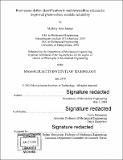| dc.contributor.advisor | Tonio Buonassisi. | en_US |
| dc.contributor.author | Jensen, Mallory Ann | en_US |
| dc.contributor.other | Massachusetts Institute of Technology. Department of Mechanical Engineering. | en_US |
| dc.date.accessioned | 2018-11-28T15:44:06Z | |
| dc.date.available | 2018-11-28T15:44:06Z | |
| dc.date.copyright | 2018 | en_US |
| dc.date.issued | 2018 | en_US |
| dc.identifier.uri | http://hdl.handle.net/1721.1/119344 | |
| dc.description | Thesis: Ph. D., Massachusetts Institute of Technology, Department of Mechanical Engineering, 2018. | en_US |
| dc.description | Cataloged from PDF version of thesis. | en_US |
| dc.description | Includes bibliographical references (pages 135-145). | en_US |
| dc.description.abstract | To meet climate targets by 2030, manufacturing capacity for photovoltaic (PV) modules must be scaled at 22-25% annual growth rate while maintaining high performance and low selling price. The most suitable material substrate to enable this scale-up is cast multicrystalline silicon (mc-Si) due to its low operating cost and capital requirements compared to other technologies. However, a new form of light-induced degradation was discovered when transitioning mc-Si to the latest high efficiency device architecture. Light- and elevated temperature-induced degradation (LeTID) causes performance to decrease by about 10% (relative) under field-relevant conditions within only four months. In this work, the root cause of LeTID is investigated in three parts: (1) Candidate hypotheses are developed for LeTID; (2) Targeted experiments are carried out toward developing a defect-based description of LeTID; and (3) The basis for a predictive model of LeTID is proposed. Techniques including minority carrier lifetime spectroscopy, synchrotron-based X-ray fluorescence, intentional contamination, and process simulation are employed to probe the defect causing LeTID. The results indicate that LeTID is caused by at least two reactants-hydrogen and one or more reactants that can be modified by high-temperature processing-and that the defect at the point of maximum degradation has recombination characteristics similar to a deep-level donor in silicon. By providing the basis for a predictive model, this work enables both identification of the root cause of LeTID and de-risking of novel solar cell architectures based on mc-Si, allowing assessment of the impact of LeTID on the future of the PV industry. This work also enables development of mitigating strategies for LeTID. | en_US |
| dc.description.sponsorship | Funding from the National Science Foundation Graduate Research Fellowship Program and grants from the National Science Foundation and the U.S. Department of Energy | en_US |
| dc.description.statementofresponsibility | by Mallory Ann Jensen. | en_US |
| dc.format.extent | 145 pages | en_US |
| dc.language.iso | eng | en_US |
| dc.publisher | Massachusetts Institute of Technology | en_US |
| dc.rights | MIT theses are protected by copyright. They may be viewed, downloaded, or printed from this source but further reproduction or distribution in any format is prohibited without written permission. | en_US |
| dc.rights.uri | http://dspace.mit.edu/handle/1721.1/7582 | en_US |
| dc.subject | Mechanical Engineering. | en_US |
| dc.title | Root cause defect identification in multicrystalline silicon for improved photovoltaic module reliability | en_US |
| dc.type | Thesis | en_US |
| dc.description.degree | Ph. D. | en_US |
| dc.contributor.department | Massachusetts Institute of Technology. Department of Mechanical Engineering | |
| dc.identifier.oclc | 1065537939 | en_US |
